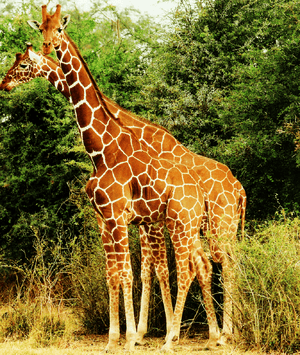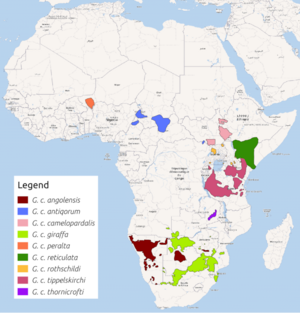Reticulated giraffe facts for kids
Quick facts for kids Reticulated giraffeTemporal range: Pleistocene - Recent
|
|
|---|---|
 |
|
| Conservation status | |
| Scientific classification | |
| Genus: |
Giraffa
|
| Species: |
reticulata
|
 |
|
| Range in dark green | |
| Synonyms | |
|
Giraffa camelopardalis reticulata |
|
The reticulated giraffe (Giraffa reticulata) is a tall and graceful animal. It is a type of giraffe that lives in the Horn of Africa. You can easily spot it by its unique coat. It has large, block-like spots that look like a net. These spots are a deep reddish-brown and cover its legs, tail, and face. There is less white space between these spots compared to other giraffe types.
Reticulated giraffes are the tallest land animals. They can grow up to 6 meters (about 20 feet) tall! While some still live in places like Somalia and Ethiopia, most of them are found in Kenya. As of 2024, there are about 8,500 reticulated giraffes living in the wild. Including those in zoos, the total number worldwide is around 15,785.
Sometimes, reticulated giraffes can have babies with other giraffe types, especially in zoos. They are one of the most common giraffes you might see in zoos and animal parks, along with the Masai giraffe and the Rothschild's giraffe.
Contents
- Understanding Giraffe Families: Taxonomy
- Where Do Reticulated Giraffes Live?
- A Day in the Life of a Reticulated Giraffe
- What Do Reticulated Giraffes Eat?
- How Reticulated Giraffes Live Together
- Reproduction and Life Cycle
- Protecting Reticulated Giraffes
- Reticulated Giraffes in Zoos
- Fun facts about the Reticulated giraffe
- See also
Understanding Giraffe Families: Taxonomy
Scientists use something called taxonomy to group living things. This helps us understand how different animals are related. As of August 2025, experts recognize four main types, or species, of giraffe. These are the northern giraffe, the reticulated giraffe, the Masai giraffe, and the southern giraffe.
Before this, all giraffes were thought to be just one species. The reticulated giraffe got its own special name, Giraffa reticulata, in 1899. A British scientist named William Edward de Winton gave it this name.
Giraffes belong to a larger group of animals. Their closest living relative is the shy okapi (Okapia johnstoni). Okapis live in Central Africa. Both giraffes and okapis have a long, dark, flexible tongue. They use it to grab leaves from trees. They also have special bony growths on their heads called ossicones. These often have tufts of fur on top. Giraffes and okapis shared a common ancestor about 11.5 million years ago.
Another distant relative is the North American pronghorn. This animal lives in North America. Even deer are distantly related to giraffes, okapis, and pronghorns!
Where Do Reticulated Giraffes Live?
Reticulated giraffes used to live across a large area of Northeast Africa. They love places with acacia trees, which are their favorite food. Their homes include savannas, dry woodlands, and even semi-deserts. They also live in areas with seasonal floodplains and open forests.
Today, you will mostly find them in Kenya. They live in famous parks like Meru National Park and Samburu National Reserve. You can also see them around the northern part of Mount Kenya. They have been seen in other areas too, such as Habaswein and Tsavo East National Park.
A Day in the Life of a Reticulated Giraffe
Reticulated giraffes are active both during the day and at night. This is called being diel. They are most busy during the cooler parts of the day. This includes dawn, dusk, and even midnight. This behavior helps them cope with their warm environment.
Giraffes don't sleep for very long at one time. They usually take short naps, often while standing up. Their sleeping periods are usually only a couple of hours long.
Each giraffe has a "home range," which is the area where it usually lives. These areas often overlap with other giraffes. Both male and female giraffes share these ranges. The size of their home range depends on how much food and water is available. Giraffes don't usually fight over their territory.
What Do Reticulated Giraffes Eat?
Reticulated giraffes are herbivores, meaning they only eat plants. Their diet mainly consists of leaves, shoots, and shrubs. Their favorite food comes from acacia trees. They have a special blue tongue that can be up to 30 centimeters (12 in) long! They use this long tongue to strip leaves from thorny branches.
Giraffes spend a lot of their day eating, about 13 hours every day. They can eat up to 34 kilograms (75 lb) of food daily. They are ruminant mammals. This means they chew their food, swallow it, and then bring it back up to chew it again. This helps them digest their high-fiber diet. The only other animals that compete with giraffes for food are elephants.
How Reticulated Giraffes Live Together
You can often see reticulated giraffes in groups of 3 to 9 animals. Sometimes, you might see a giraffe all by itself. Female giraffes often form groups with their relatives. These groups are usually mothers and their young.
Female giraffes are known to help protect each other's babies from predators. This teamwork helps keep the young ones safe.
Reproduction and Life Cycle
Females show they are ready to have babies by giving off a special scent. This breeding cycle happens about every 15 days. A male giraffe can smell this scent better by curling his lip. This action helps bring the scent to a special organ in his nose. Stronger males will stay close to females ready to breed to make sure other males don't bother them.
When a male is ready to mate, he gently taps the female's leg or rests his head on her back. After breeding, the male and female usually go their separate ways.
A female reticulated giraffe is pregnant for about 445 to 457 days. This is a very long time, almost 15 months! She usually gives birth to one baby. Having two babies is very rare. The mother gives birth while standing up. Amazingly, the baby giraffe can stand up on its own just 5 to 20 minutes after being born! Young giraffes drink their mother's milk for 6 to 17 months. They become fully independent when they are about 2 years old.
Protecting Reticulated Giraffes
There are about 8,500 reticulated giraffes left in the wild. Many groups are working hard to protect them. One important group is San Diego Zoo Global's "Twiga Walinzi" initiative. "Twiga Walinzi" means "Giraffe Guards" in Swahili.
This group hires and trains local Kenyans to help. They set up 120 cameras in Northern Kenya to watch wild giraffes and other animals. They also create a special photo ID database. This helps them track individual giraffes. The "Giraffe Guards" also tell rangers about poaching (illegal hunting) and remove dangerous traps. They even care for baby giraffes that have lost their mothers. Most importantly, they teach local communities about why it's so important to protect giraffes. Thanks to these efforts, the number of giraffes in protected areas remains stable.
Reticulated Giraffes in Zoos
The reticulated giraffe is one of the most common types of giraffes you can see in zoos. The Rothschild's giraffe and the Masai giraffe are also often found in zoos.
The Cheyenne Mountain Zoo in Colorado Springs, Colorado has the largest group of reticulated giraffes in North America. In the past, reticulated and Rothschild's giraffes were sometimes bred together in zoos. This was because people thought these different types of giraffes might breed in the wild. However, research from 2016 showed that they actually don't interbreed in nature. Even so, some zoos still continue to breed them together.
Some zoos keep different types of giraffes separate. For example, the San Diego Zoo and its San Diego Zoo Safari Park have all three types: Masai, Rothschild's, and Reticulated giraffes. Other zoos, like the Bronx Zoo in New York and the UK's Chester Zoo, only have Rothschild's giraffes. Zoos such as the Cheyenne Mountain Zoo (Colorado), Busch Gardens Tampa (Florida), and Omaha's Henry Doorly Zoo (Nebraska) focus on caring for only Reticulated giraffes.
Fun facts about the Reticulated giraffe
- The name "reticulated" comes from the Latin word 'reticulum', meaning "network" or "net." This perfectly describes their coat, which looks like a beautiful net of white lines laid over a rich, reddish-brown background.
- No two reticulated giraffes have exactly the same pattern. The patches can vary in color from bright orange to dark chestnut, and the white lines can be thick or thin.
- Despite having incredibly long necks, they have the same number of neck vertebrae as a human: just seven! Each vertebra is just super-sized, up to 10 inches long.
- A giraffe's tongue is a whopping 18-20 inches (46-50 cm) long! It's also a distinctive blue-black or purple color.
- In the wild, adult giraffes sleep the least of any mammal. They typically get only 5 to 30 minutes of deep sleep per day, often in quick power naps that last just a minute or two.
- A baby reticulated giraffe, called a calf, enters the world in a dramatic way—by falling over 5 feet (1.5 meters) to the ground from the standing mother!
See also
 In Spanish: Jirafa reticulada para niños
In Spanish: Jirafa reticulada para niños



